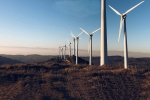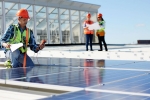New renewable energy development: Hard work for green energy
This article has been translated by PwC Indonesia as part of our Indonesia Infrastructure News Service. PwC Indonesia has not checked the accuracy of, and accepts no responsibility for the content.
Bisnis Indonesia: Pengembangan EBT: Kerja keras untuk energi hijau
28 October 2019
By: Ni Putu Eka Wiratmini
The door for new renewable energy development in Indonesia is wide open. However, hard work is still required to widen the road for the future energy development.
Starting this year, the government has announced that investments in new renewable energy could be made with disregard to the Electricity Supply Business Plan of PT PLN (Persero). The announcement should have been a positive signal for developers to race to invest in new renewable energy power plants.
In its development until the 10th month of 2019, the Energy and Mineral Resources Ministry recorded that there had yet to be a single investment in new renewable power plants that capitalised on the opportunity.
“Especially for new renewable energy, we want everything to be easy and quick, but not violating the rules,” Director General of Electricity of the Energy and Mineral Resources Ministry Rida Mulyana said last week.
Besides providing a large opportunity for new renewable energy power plants, the government has also assertively stated that they were no longer accepting the development of coal power plants on the Java-Bali electricity system.
Only coal power plants with old contracts can continue construction.
Outside of the Java-Bali system, investments in coal power plants are acceptable, but it has to be a mine-mouth coal-fired power plant (PLTU).
Until the first half of 2019, the power plant energy mix is 61.85% from coal, 21.12% from gas, 12.71% from new renewable energy, and 4.32% from fuel oil and biofuel.
On the other hand, the government targets that new renewable energy power plants will have a capacity of 15.4 gigawatts (GW) by 2025.
Even though fossil energy is still dominating, the number of new renewable energy power plants are increasing. For example, in 2019, operational new renewable energy power plants are set to have a capacity of 560 MW. In 2020, new renewable energy power plants are set to receive an additional 933 MW.
Until the third quarter of 2019, there has been 445 MW of new renewable power plants that are commercially operational.
Meanwhile, PLN Acting President Director Sripeni Inten Cahyani said that her company would cooperate with the Public Works and Public Housing (PUPR) Ministry to build several hydropower plants (PLTA) to increase the new renewable energy mix.
Later, the reservoir that is built by the PUPR Ministry will be utilised by PLN as a PLTA.
Based on Bisnis records, the potential of water in Indonesia which can be utilised for power plants reaches 24,337 GW.
Besides PLTA, PLN will boost the new renewable energy mix through the development of geothermal power plants (PLTP) and rooftop solar power plants (PLTS).
Based on data from Energy and Mineral Resources Ministry, there is another operational PLTP this year, which is Lumut Balai I PLTP with a capacity of 50 MW that has been operational since the end of August 2019 which increased the geothermal energy mix in power plants to be 2,003.5 MW.
Next, there are two power plants set to be operational this year, namely Muara Laboh PLTP Unit 1 in West Sumatra by Supreme Energy with a capacity of 80 MW, and Sorik Merapi 1 PLTP in North Sumatra by Sorik Merapi Geothermal Power with a capacity of 45 MW.
The government has also issued a number of regulations that boost investments in rooftop PLTS.
PLN Finance Director Sarwono Sudarto predicted that, this year, several new renewable energy power plants, with a total capacity of around 700 MW to 800 MW, would be operational with an investment value of Rp14 trillion.
According to him, investment from PLN in new renewable energy power plants will increase. “The exact amount [will be announced] later, but it will reach 23% by 2025,” he said.
Hindering Factors
However, the plan is not as easy as it seems. Several investors still have problems which make investments in new renewable energy hampered.
One of the problems is Energy and Mineral Resources Minister Regulation Number 50 of 2017 on The Use of Renewable Energy for The Provision of Electricity. The regulation states that the price ceiling for the purchase of PLN’s electricity from producers is 85% of the local main cost of electricity.
Indonesian Private Electricity Producers Association (APLSI) President Director Arthur Simatupang said that, in developing new renewable energy power plants, each one had different problems.
For example, wind power plant (PLTB) development require exploration, so infrastructure must be built in the region.
PLTB and PLTS developments are intermittent, so developers need to spend more. The same goes for waste power plants (PLTSa) which are often complicated by the tipping fee that must be paid for by the regional government.
According to him, the problems diminish the enthusiasm of private electricity produces that want to develop new renewable energy power plants. Arthur reckoned that investments in new renewable energy power plants needed many reorganisations so that it could develop.
“We are still hoping [for the development to be] intensive, the capacity of new renewable energy [power plants] are still small, the power is less as economic scale is smaller, so it cannot compete with PLTUs in Java with large capacities, such as 1,000 MW,” he said.
New renewable energy as the main source of energy in the future is an inevitability. Now, it is up to how the relevant parties collaborate in accelerating the development of the green energy.
All parties have their own role.
New renewable energy power plant capacity in H2 2019 (MW) |
||
Type |
On-grid |
Off-grid |
PLTP (Geothermal Power Plant) |
1,949.30 |
- |
PLTA (Hydropower Plant) |
4,479.92 |
938 |
PLTM (Mini Hydropower Plant) |
277.14 |
- |
PLTMH (Micro Hydropower Plant) |
98.39 |
6.38 |
PLTB (Wind Power Plant) |
153.83 |
0.48 |
PLTBG (Biogas Power Plant) |
40.35 |
68.26 |
PLTBM (Biomass Power Plant) |
142.02 |
1,616.52 |
PLTS (Solar Power Plant) |
43.08 |
35.77 |
PLTSA (Waste Power Plant) |
15.65 |
- |
Hybrid Power Plant |
- |
3.58 |
Energy Mix (%) |
2014 |
2015 |
2016 |
2017 |
2018 |
Q1 2019 |
Fuel oil and biofuel |
11.69 |
8.50 |
6.95 |
6 |
5.98 |
4.42 |
Coal |
52.59 |
55.79 |
54.45 |
58.14 |
59.91 |
61.82 |
Gas |
24.58 |
25.34 |
26.28 |
23.33 |
22.25 |
21.01 |
Water |
6.63 |
5.87 |
7.79 |
7.32 |
6.30 |
7.51 |
New renewable energy |
4.50 |
4.49 |
4.53 |
5.22 |
5.56 |
5.23 |

















